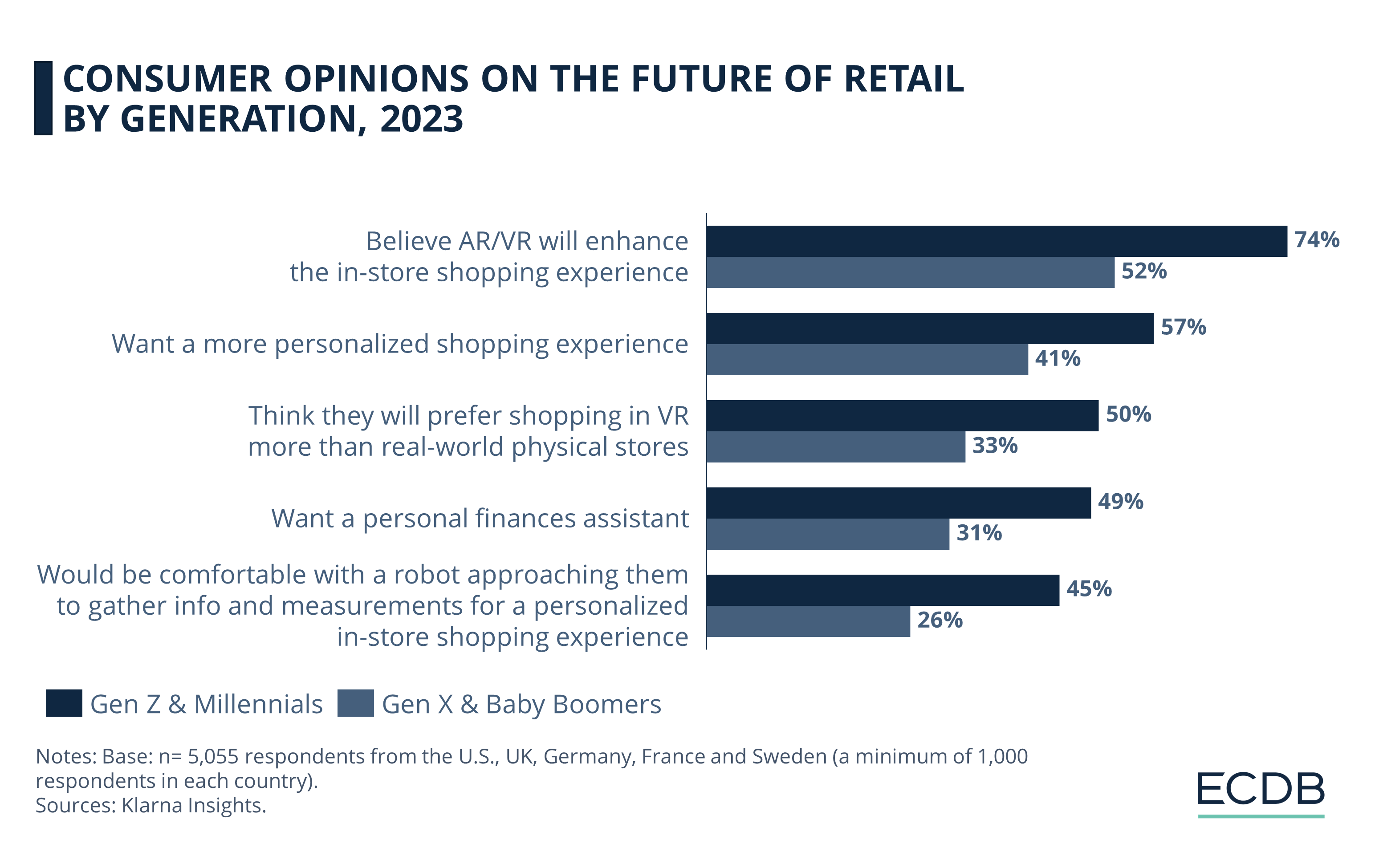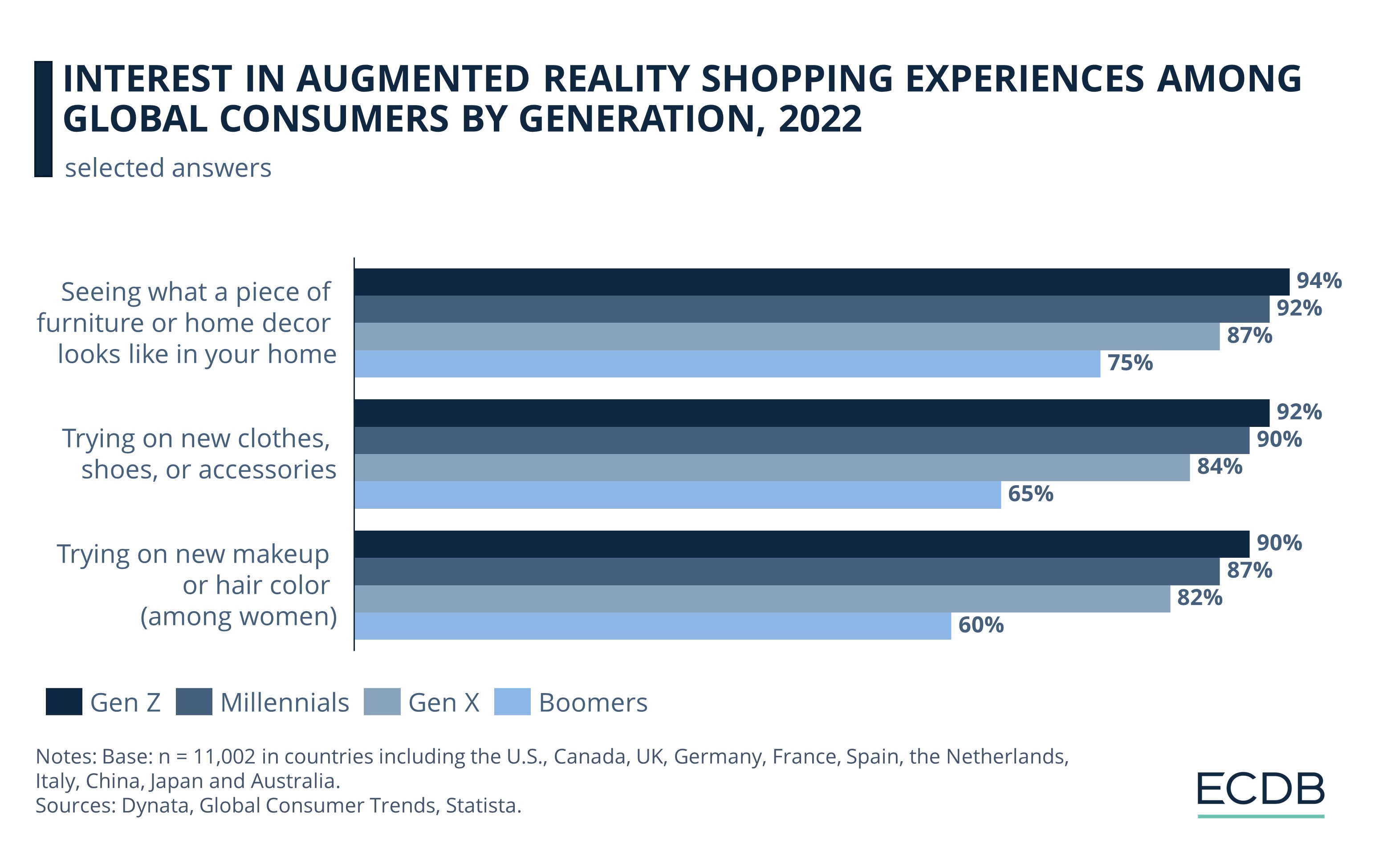eCommerce: Augmented Reality
Apple’s Vision Pro: What Impact Does It Have on eCommerce?
Explore how Apple's Vision Pro and AR are transforming eCommerce with immersive experiences, enhanced personalization, and social shopping innovations.
May 24, 2024Download
Coming soon
Share

Apple's Vision Pro: Key Insights
Vision Pro in eCommerce: Apple's Vision Pro could revolutionize eCommerce by enabling seamless, immersive experiences through fast sensor data processing and intuitive interaction methods.
AR's Impact: Augmented Reality is transforming eCommerce by enabling immersive shopping experiences, with significant adoption by younger generations and major brands like Snap Inc. and IKEA integrating AR to enhance customer engagement and personalization.
Enhanced Reality: Apple's Vision Pro distinguishes itself from Meta's headsets by enhancing reality with AR, keeping users connected to their environment, which is beneficial for eCommerce as it allows for better product visualization and informed purchasing decisions.
Vision Pro Criticisms: The Vision Pro, while praised for its high-quality display and seamless integration with Apple's ecosystem, faces criticism for its cumbersome design, inconsistent EyeSight feature, imprecise tracking, difficult calibration for glasses users, high cost, and potential for causing social isolation.
Today, what we consider futuristic is changing very fast. We may not have flying cars hovering over cities yet, but we do have gadgets that we can put on our heads and have reality change before our eyes.
You have probably seen the videos of people wearing this big Apple headset, walking around in public and making a spectacle of themselves.
The headset is called Vision Pro, but what is it? More importantly (for us at least), what does it do for online shopping?
What is Apple's Vision Pro?
During last year's annual developer conference, Apple revealed its bold move into the augmented reality (AR) market with the introduction of their headset, Vision Pro.
The headset processes sensor data lightning-fast and allows users to navigate content easily by using their eyes and fingers. Apple’s latest marvel can also be used in conjunction with a trackpad and keyboard, mimicking the functionality of a traditional computer with multiple displays.

How does that play out for eCommerce, though?
Apple's Vision Pro: Use in eCommerce
With its exciting technical features, Vision Pro might open new doors in the implementation of AR for eCommerce purposes.
Fast processing of sensor data, for instance, would enable users to seamlessly navigate through immersive eCommerce experiences using their eyes, enhancing the sense of presence and engagement.
Additionally, innovative interaction methods such as tapping fingers together for clicks, as well as flicks for scrolling further would enhance the user experience by providing intuitive and natural ways to interact with products.
Moreover, compatibility with a trackpad and keyboard is likely to prove useful in offering a familiar interface for users, allowing a smoother transition to using such technology.
For better context and understanding what this device can really do, let's take a step back and take a look at the bigger picture: the use of AR in online shopping.
Augmented Reality in eCommerce
Fancy headsets aside, there are already noteworthy applications of this revolutionary technology in eCommerce.
Metaverse Fashion Week, for example, is a digital fashion event held on the Metaverse platform Decentraland, offering shoppers wearable collections through the use of AR. Last year’s edition of the event included the likes of Dolce & Gabbana, Hugo Boss, adidas, Alo Yoga, Tommy Hilfiger, and Dundas Worldwide.

Research shows that Gen Z & Millennials are more open to tech-supported retail, with 74% believing AR/VR will enhance in-store shopping and 57% wanting more personalized experiences. In contrast, 52% of Gen X & Baby Boomers believe AR/VR will enhance in-store shopping, and 41% want more personalized experiences.
In addition, AR technology is also a good tool to implement for companies that intend to diversify their business. As a part of its efforts to become more involved in eCommerce, Snap Inc. is one of the many companies that have embraced the usage of AR. Through the “Lenses” created by a community of over 300,000 creators and developers, the company gives customers the opportunity to try on clothing and accessories in an immersive online shopping experience.

Retail chain IKEA, too, has incorporated AR into their repertoire. Through the app IKEA Place, users are able to virtually place 3D models of furniture from IKEA’s catalogue in their own space, helping them visualize and experiment with different products before making a purchase. This smart and simple idea offers an engaging and convenient way to explore furnishing ideas through the lens of a smartphone camera.
Augmented Reality vs. Virtual Reality:
Which One is Better in Online Shopping?
Distinguishing itself from the technology giant Meta's headsets, the Vision Pro features a visually striking element – an exterior display that showcases the user's eyes to individuals in the surrounding environment, making it "the first Apple product you look through, not at", as the CEO Tim Cook puts it.
While this outer screen is turned off when a user is completely engaged in a virtual world, in case of a person approaching the user, the headset then shows the user and the outside person to each other. The user, in this case, sees the outside world through a more basic video feed. But more on that later.
According to Carolina Milanesi, an analyst at Creative Strategies, the fundamental difference between Apple's headset and Meta's is that Meta aims to create a virtual world that users inhabit, while Apple seems to prefer to keep users firmly rooted in reality and simply enhance it.
In the context of eCommerce, whether AR is more advantageous than virtual reality (VR) is, of course, dependent on the use case. One key strength of AR is the ability to maintain a connection with the real world. By blending digital content seamlessly with the real world, AR allows users to stay connected to their surroundings while adding digital elements to their view.
This might be argued to be particularly beneficial for eCommerce, as it enables users to visualize products in their own environment and make more informed purchasing decisions.

A study reveals that Gen Z and Millennials are the most interested in using AR for online shopping. In 2022, 94% of Gen Z shoppers wanted to see furniture in their homes using AR, compared to 75% of Boomers. Overall, consumer preference for AR is highest for Furniture & Homeware across all generations.
While VR has its merits in creating immersive experiences, it may limit the user's ability to interact with the physical world by isolating users from their physical environment and putting them in a virtual world. However, to underline again, different eCommerce usages of these technologies might favor one over the other.
In any case, Apple's emphasis on enhancing reality rather than creating a separate virtual world aligns with the idea of AR as a powerful tool for complementing the eCommerce experience.
Apple's Vision Pro:
Critique and User Feedback
Since its release, the Vision Pro has received a mix of praise and criticism. Users appreciate the high-quality display and seamless integration with Apple's ecosystem, enhancing eCommerce by allowing product visualization in users' environments. However, several critical issues have emerged:
Cumbersome Design: The headset's weight and external battery pack make it inconvenient for prolonged use and disrupt daily interactions.
EyeSight Feature: Though promoted to be ground-breaking, the feature often fails to be noticeable in different lighting conditions, adding to the awkwardness.
Tracking Precision: Eye and hand tracking is innovative but not always precise, leading to user frustration.
Cumbersome Calibration: For users with glasses, the calibration process is less effective compared to other headsets like the Meta Quest 2.
High Cost: The Vision Pro's high price and necessary accessories, like prescription inserts, pose significant barriers to entry.
Social Isolation: The headset can isolate users from their surroundings, making spontaneous communication difficult and negatively impacting in-person interactions.
Apple's Vision Pro in eCommerce:
Closing Thoughts
The future of AR holds exciting possibilities for eCommerce. It can lead to improved personalization by analyzing user preferences and context, enabling highly tailored experiences that recommend products, styles, or sizes aligning with individual tastes and needs. Additionally, AR can also enhance social shopping by allowing users to share their AR experiences with friends, enabling virtual shopping together, seeking opinions, and making group decisions.
Furthermore, AR has the potential to enhance in-store experiences by overlaying additional information, personalized offers, or navigation assistance onto the physical environment, benefiting brick-and-mortar stores. Moreover, gamification elements can be incorporated into shopping using AR, making the experience more engaging and enjoyable for users.
Overall, AR’s potential to change the way consumers shop online cannot be overstated. Though a healthy dose of skepticism is always important when it comes to novel technologies, implementation of such immersive experiences will surely have an impact on customer satisfaction and engagement by bridging the gap between the digital and physical worlds.
Sources: Snap AR, BigCommerce, Reuters, Mixed, TechRadar, ZDNET, Wired, CNET, The Verge, ECDB

Click here for
more relevant insights from
our partner Mastercard.
Related insights
Deep Dive
Online Shopping in the United States: Where Consumers Prefer to Shop Online
Online Shopping in the United States: Where Consumers Prefer to Shop Online
Deep Dive
Top Online Payment Methods in the United Kingdom: Cards & eWallets
Top Online Payment Methods in the United Kingdom: Cards & eWallets
Deep Dive
Inside Apple Revenue: Latest Sales Figures and Key Insights
Inside Apple Revenue: Latest Sales Figures and Key Insights
Deep Dive
eCommerce in the United States: Top 5 Companies by Revenue
eCommerce in the United States: Top 5 Companies by Revenue
Deep Dive
Top 10 Online Shopping Sites in the USA: Amazon, Walmart, Apple
Top 10 Online Shopping Sites in the USA: Amazon, Walmart, Apple
Back to main topics